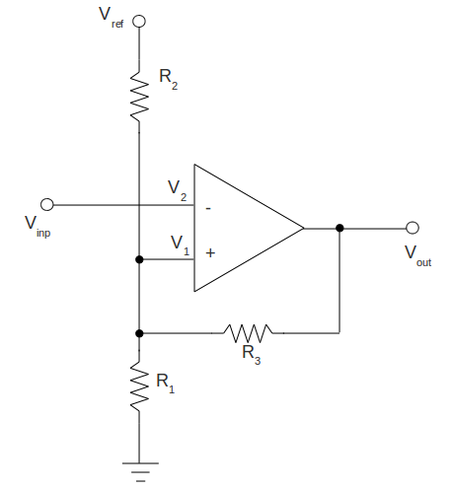Difference between revisions of "GradFinalLab RS"
| Line 51: | Line 51: | ||
Substituting all quantities in the formulas above: | Substituting all quantities in the formulas above: | ||
| − | <math>R_{123} = (1.01\pm 0.01)\ k\Omega || (1.01\pm 0.01)\ k\Omega || (5.10\pm 0.05)\ k\Omega = (0.459\pm 0.003)\ k\Omega</math> | + | <math>R_{123} = (1.01\pm 0.01)\ k\Omega\ ||\ (1.01\pm 0.01)\ k\Omega\ ||\ (5.10\pm 0.05)\ k\Omega = (0.459\pm 0.003)\ k\Omega</math> |
<math>V_2 = \frac{(0.459\pm 0.003)\ k\Omega}{(1.01\pm 0.01)\ k\Omega}(11.90\pm 0.01)\ V + \frac{(0.459\pm 0.003)\ k\Omega}{(5.10\pm 0.05)\ k\Omega}(11.06\pm 0.01)\ V</math> | <math>V_2 = \frac{(0.459\pm 0.003)\ k\Omega}{(1.01\pm 0.01)\ k\Omega}(11.90\pm 0.01)\ V + \frac{(0.459\pm 0.003)\ k\Omega}{(5.10\pm 0.05)\ k\Omega}(11.06\pm 0.01)\ V</math> | ||
Revision as of 03:19, 27 April 2011
Construct a Schmitt Trigger using the 741 Op Amp
Draw the Schmitt Trigger circuit you constructed. Identify the values of all components
To construct the circuit above I am going to use the following components and voltages:
Graph as a function of . Is there a hysteresis loop?
Identify the input voltage threshold levels at which a will produce
Compare the threshold values to what is expected.
The theory does say (ch. 10.19 The Schmitt Trigger R. Simpson "Introductory electronics for scientists and engineers"):
1) if the output is high:
2) if the output is low:
where
and and approximately equal to supply voltage
The actual measured values of high and low output voltages (they do not really equal to ) are:
Substituting all quantities in the formulas above:
and doing math and propagating errors we end up with the following predicted threshold voltages:
1) If the output voltage is high the threshold voltage are:
1) If the output voltage is low the threshold voltage are:
Go Back to All Lab Reports Forest_Electronic_Instrumentation_and_Measurement
